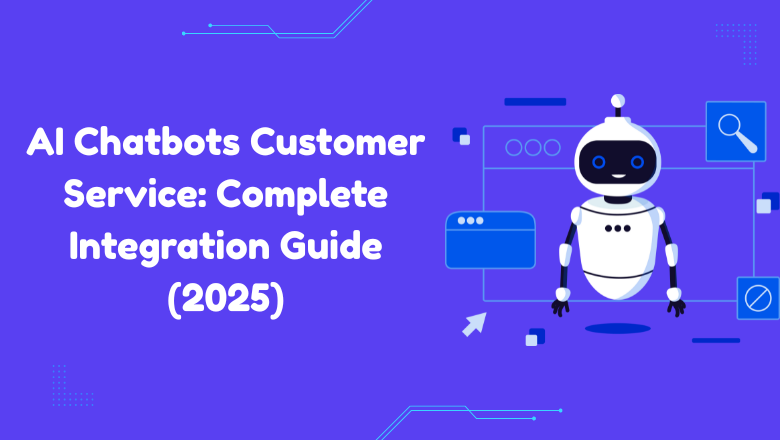
Exceptional customer service is no longer optional—it’s essential for success. AI chatbots customer service solutions have emerged as powerful tools that can transform how businesses interact with their customers. These virtual assistants respond to inquiries instantly and operate around the clock, creating seamless customer experiences that drive satisfaction and loyalty.
This comprehensive guide explores how to integrate AI chatbots into your existing customer service framework, providing a detailed roadmap for implementation that will help you enhance customer interactions across your website, mobile app, and other communication channels.
Customer service chatbots have revolutionized how businesses interact with their clients online. These automated systems leverage artificial intelligence to quickly address inquiries, provide information, and resolve issues without human intervention. According to a Tidio survey, an impressive 62% of customers actually prefer interacting with chatbots rather than waiting for human support—a statistic that highlights the growing acceptance of this technology.
The advantages of implementing customer service chatbots extend far beyond just reducing workload at support centers:
AI customer service technology has fundamentally changed how businesses approach customer support. Unlike traditional rule-based systems, modern AI-powered solutions offer truly conversational experiences without the limitations of scripted responses.
Customer service powered by artificial intelligence can interpret the intent of questions using machine learning and natural language processing (NLP). These systems don’t simply select predetermined responses—they generate real-time answers for each query, learning from every interaction and continuously improving their performance.
AI customer service tools can:
While AI chatbots customer service solutions can’t completely replace human interaction yet, they create a hybrid experience that combines the efficiency of automation with the empathy of human support when needed.
Successfully implementing chatbots in customer service requires careful planning and execution. Follow these 12 essential steps to ensure your chatbot integration enhances rather than disrupts your customer experience:
Before beginning the implementation process, define specific customer service tasks you want your chatbot to perform. Common examples include answering frequently asked questions, streamlining order processing, and efficiently resolving simple issues. Setting clear goals is fundamental to a smooth integration process.
Developing an effective chatbot requires thorough knowledge of your audience. Research their preferences, needs, and communication styles, considering factors like language proficiency, demographics, and specific requirements that might affect your chatbot’s design and functionality.
Conversational AI:
Generative AI:
Select the approach that best aligns with your customer service goals and technical capabilities.
Implementing AI customer support requires attention to several critical areas:
Choose a platform with robust natural language processing capabilities that enable human-like conversations. The platform selection significantly impacts user experience and communication quality, so evaluate NLP features carefully during the selection process.
Develop a well-structured, intuitive conversation flow to guide customers through their interactions with the chatbot. Consider the user’s journey at each interaction point and anticipate their needs. To create an effective dialogue flow:
To train your chatbot effectively:
The quality and relevance of your training data directly impact your chatbot’s performance and ability to provide helpful responses.
Selecting the right AI chatbot for customer service depends on your specific business needs and customer expectations. Consider these additional implementation steps:
For seamless operation, your chatbot must communicate effectively with databases, APIs, and other systems. Identify necessary connections and ensure your chatbot can retrieve and update data as needed by:
Proper integration leverages existing information and capabilities within your organization, providing a more comprehensive and valuable user experience.
To deliver a consistent and integrated customer experience, implement multichannel support that allows your chatbot to interact with customers across various channels, including phone, email, chat, and social media. This approach enables customers to move between platforms while maintaining conversation context.
To implement multi-channel support effectively:
After development, thoroughly test your chatbot to ensure it correctly interprets user queries and provides relevant answers. Track key metrics like response times, user satisfaction, and issue resolution rates. The testing process should include:
AI chatbots require ongoing maintenance and enhancement. This includes:
With continuous improvement, your AI chatbot becomes a valuable 24/7 asset that increases productivity, sales, and customer satisfaction.
While chatbots can handle many tasks, some situations require human assistance. Establish a seamless process for transitioning from chatbot to human support when necessary:
Finally, proactively request customer feedback to drive continuous improvement. Use methods like customer reviews, surveys, and dedicated feedback channels to identify areas for enhancement and gauge user satisfaction.
While the benefits are substantial, implementing AI chatbots in customer service comes with challenges:
Addressing these challenges early in the implementation process can prevent customer frustration and ensure a successful deployment.
Implementing AI chatbots customer service solutions is a strategic move in today’s digital landscape. By following this step-by-step guide, you can deploy an effective AI chatbot that enhances customer satisfaction, streamlines support processes, and frees up valuable human resources.
The key to successful implementation lies in setting specific goals, understanding your audience, utilizing appropriate technology, creating effective conversation flows, and continuously improving your chatbot through optimization and user feedback.
By adhering to these steps, you can develop a powerful tool that enhances the efficiency and quality of your customer service initiatives, creating 24/7 touchpoints across the entire customer journey.